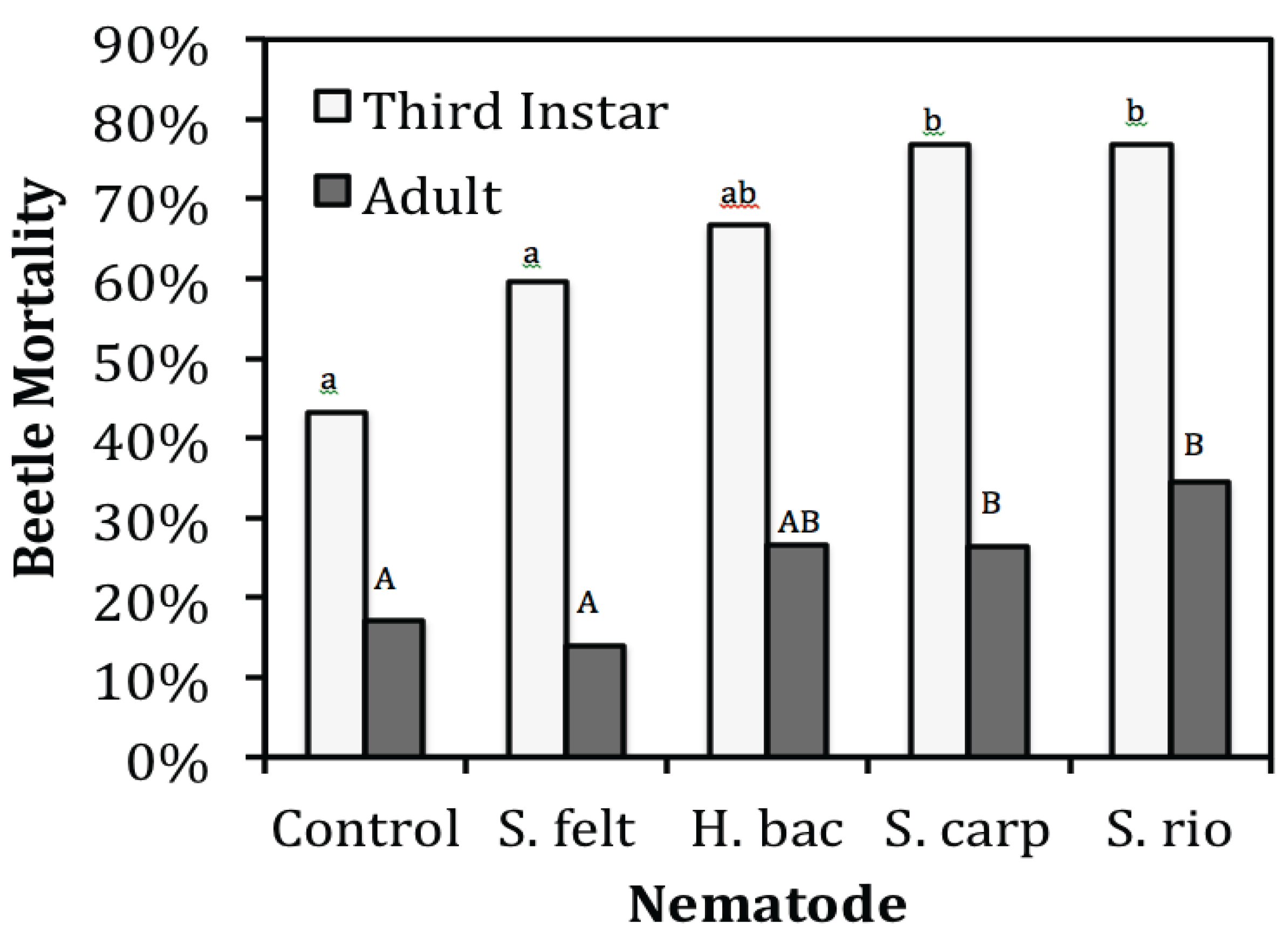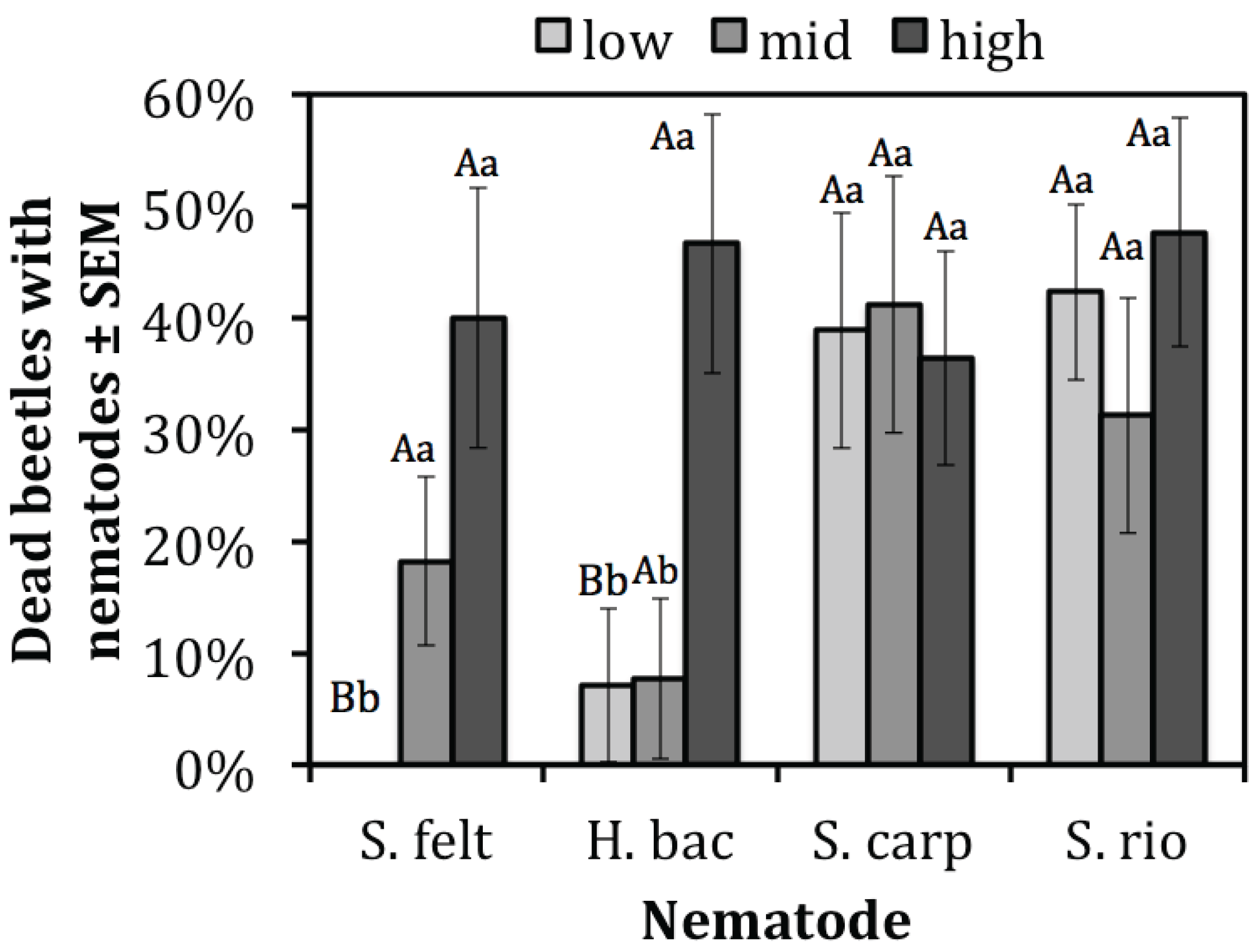Susceptibility of Dalotia coriaria (Kraatz) (Coleoptera: Staphylinidae) to Entomopathogenic Nematodes (Rhabditida: Heterorhabditidae and Steinernematidae)
Abstract
:1. Introduction
2. Experimental Section
2.1. Insect Rearing and Nematode Cultures
2.2. Experimental Methods
2.3. Statistical Analysis
| Model | AIC |
|---|---|
| EPN + Rate + stage + EPN:Rate + EPN:stage + Rate:stage + EPN:Rate:stage + Block | 263.33 |
| EPN + Rate + stage + EPN:Rate + EPN:stage + Rate:stage + EPN:Rate:stage | 255.15 |
| EPN + Rate + stage + EPN:Rate + EPN:stage + Rate:stage | 252.82 |
| EPN + Rate + stage + EPN:Rate + EPN:stage | 250.80 |
| EPN + Rate + stage + EPN:Rate | 249.30 |
3. Results
3.1. Beetle Mortality

3.2. Presence of Nematodes in Cadavers

4. Discussion
5. Conclusions
Acknowledgments
Author Contributions
Conflicts of Interest
References
- Shipp, L.; Elliott, D.; Gillespie, D.; Brodeur, J. From Chemical to Biological Control in Canadian Greenhouse Crops. In Biological Control: A Global Perspective: Case Studies from Around the World; CABI Publishing: Cambridge, MA, USA, 2007; pp. 118–127. [Google Scholar]
- Jensen, S.E. Insecticide resistance in the western flower thrips, Frankliniella occidentalis. Integr. Pest Manag. Rev. 2000, 5, 131–146. [Google Scholar] [CrossRef]
- Reitz, S.R. Biology and ecology of the western flower thrips (Thysanoptera: Thripidae): The making of a pest. Fla. Entomol. 2009, 92, 7–13. [Google Scholar] [CrossRef]
- Xu, X.; Borgemeister, C.; Poehling, H.-M. Interactions in the biological control of western flower thrips Frankliniella occidentalis (Pergande) and two-spotted spider mite Tetranychus urticae Koch by the predatory bug Orius insidiosus Say on beans. Biol. Control 2006, 36, 57–64. [Google Scholar] [CrossRef]
- Manners, A.G.; Dembowski, B.R.; Healey, M.A. Biological control of western flower thrips, Frankliniella occidentalis (Pergande) (Thysanoptera: Thripidae), in gerberas, chrysanthemums and roses. Aust. J. Entomol. 2013, 52, 246–258. [Google Scholar] [CrossRef]
- Gouge, D.H.; Hague, N.G.M. Glasshouse control of fungus gnats, Bradysia paupera, on fuchsias by Steinernema feltiae. Fundam. Appl. Nematol. 1995, 18, 77–80. [Google Scholar]
- Harris, M.A.; Oetting, R.D.; Gardner, W.A. Use of entomopathogenic nematodes and a new monitoring technique for control of fungus gnats, Bradysia coprophila (Diptera: Sciaridae), in Floriculture. Biol. Control 1995, 5, 412–418. [Google Scholar] [CrossRef]
- Jagdale, G.B.; Casey, M.L.; Cañas, L.; Grewal, P.S. Effect of entomopathogenic nematode species, split application and potting medium on the control of the fungus gnat, Bradysia difformis (Diptera: Sciaridae), in the greenhouse at alternating cold and warm temperatures. Biol. Control 2007, 43, 23–30. [Google Scholar] [CrossRef]
- Carney, V.A.; Diamond, J.C.; Murphy, G.D.; Marshall, D. The potential of Atheta coriaria Kraatz (Coleoptera: Staphylinidae), as a biological control agent for use in greenhouse crops. IOBC WPRS Bull. 2002, 25, 37–40. [Google Scholar]
- Miller, K.V.; Williams, R.N. Biology and host preference of Atheta coriaria (Coleoptera: Staphylinidae), an egg predator of Nitidulidae and Muscidae. Ann. Entomol. Soc. Am. 1983, 76, 158–161. [Google Scholar] [CrossRef]
- Jandricic, S.; Scott-Dupree, C.D.; Broadbent, A.B.; Harris, C.R.; Murphy, G. Compatibility of Atheta coriaria with other biological control agents and reduced-risk insecticides used in greenhouse floriculture integrated pest management programs for fungus gnats. Can. Entomol. 2006, 138, 712–722. [Google Scholar] [CrossRef]
- Echegaray Wilson, E.R. Life Cycle of the Rove Beetle, Atheta coriaria (Kraatz) (Coleoptera: Staphylinidae) and Suitability as a Biological Control Agent against the Fungus Gnat, Bradysia sp. nr. Coprophila (Lintner); Kansas State University: Manhattan, KS, USA, 2012. [Google Scholar]
- Bennison, J.; Maulden, K.; Maher, H.; Tomiczek, M. Development of a grower rearing-release system for Atheta coriaria, for low cost biological control of ground-dwelling pest life stages. IOBCwprs Bull. 2008, 32. [Google Scholar]
- Bennison, J.; Croft, P.; Maher, H.; Maulden, K. Protected Herbs, Ornamentals and Celery: Development of an On-nursery Rearing System for Atheta coriaria for Reduced Cost Biological Control of Sciarid and Shore Flies. Available online: http://www.hdc.org.uk/project/protected-herbs-ornamentals-and-celery-development-nursery-rearing-system-atheta-coriaria-10 (accessed on 20 February 2015).
- Kaya, H.K.; Gaugler, R. Entomopathogenic nematodes. Annu. Rev. Entomol. 1993, 38, 181–206. [Google Scholar] [CrossRef]
- Ebssa, L.; Borgemeister, C.; Berndt, O.; Poehling, H.-M. Efficacy of entomopathogenic nematodes against soil-dwelling life stages of western flower thrips, Frankliniella occidentalis (Thysanoptera: Thripidae). J. Invertebr. Pathol. 2001, 78, 119–127. [Google Scholar] [CrossRef] [PubMed]
- Chyzik, R.; Glazer, I.; Klein, M. Virulence and efficacy of different entomopathogenic nematode species against western flower thrips (Frankliniella occidentalis). Phytoparasitica 1996, 24, 103–110. [Google Scholar] [CrossRef]
- Premachandra, W.T.S.D.; Borgemeister, C.; Berndt, O.; Ehlers, R.-U.; Poehling, H.-M. Combined releases of entomopathogenic nematodes and the predatory mite Hypoaspis aculeifer to control soil-dwelling stages of western flower thrips Frankliniella occidentalis. BioControl 2004, 48, 529–541. [Google Scholar] [CrossRef]
- Ebssa, L.; Borgemeister, C.; Poehling, H.-M. Effectiveness of different species/strains of entomopathogenic nematodes for control of western flower thrips (Frankliniella occidentalis) at various concentrations, host densities, and temperatures. Biol. Control 2004, 29, 145–154. [Google Scholar] [CrossRef]
- Lewis, E.E.; Campbell, J.; Griffin, C.; Kaya, H.; Peters, A. Behavioral ecology of entomopathogenic nematodes. Biol. Control 2006, 38, 66–79. [Google Scholar] [CrossRef]
- Baweja, V.; Sehgal, S.S. Potential of Heterorhabditis bacteriophora Poinar (Nematoda, Heterorhabditidae) in parasitizing Spodoptera litura Fabricius in response to malathion treatment. Acta Parasitoligica 1997, 42, 168–172. [Google Scholar]
- Campbell, J.F.; Gaugler, R. Nictation behavior and it’s ecological implications in the host search strategies of entomopathogenic nematodes (Heterorhabditidae and Steinernematidae). Behavior 1993, 126, 155–169. [Google Scholar] [CrossRef]
- Grewal, P.S.; Lewis, E.E.; Gaugler, R.; Campbell, J.F. Host finding behaviour as a predictor of foraging strategy in entomopathogenic nematodes. Parasitology 1994, 108, 207–215. [Google Scholar] [CrossRef]
- BeckerUnderwood Nemasys® Advanced Biocontrol for Fungus Gnats and Western Flower thrips in Greenhouse Growing Operations 2013. Available online: http://www.plantproducts.com/ca/images/Nemasys%20label.pdf (accessed on 11 March 2015).
- Kaya, H.K.; Stock, S.P. Techniques in insect nematology. Man. Tech. Insect Pathol. 1997, C6, 281–324. [Google Scholar]
- White, G.F. A method for obtaining infective nematode larvae from cultures. Science 1927, 66, 302–303. [Google Scholar] [CrossRef] [PubMed]
- Ramos-Rodríguez, O.; Campbell, J.F.; Ramaswamy, S.B. Pathogenicity of three species of entomopathogenic nematodes to some major stored-product insect pests. J. Stored Prod. Res. 2006, 42, 241–252. [Google Scholar] [CrossRef]
- SAS Institute Inc. SAS/STAT 9.2 User’s Guide; SAS Institute Inc.: Cary, NC, USA, 2008. [Google Scholar]
- Therneau, T.M. Modeling Survival Data: Extending the Cox Model; Springer Science & Business Media: New York, NY, USA, 2000. [Google Scholar]
- Statistical Package R. R: A Language and Environment for Statistical Computing; The R Foundation for Statisitical Computing: Vienna, Austria, 2014. [Google Scholar]
- Kuhn, M.; Contributions from Steve Weston; Wing, J.; Forester, J.; Thaler, T. Contrast: A Collection of Contrast Methods. Available online: http://rpackages.ianhowson.com/cran/contrast/ (accessed on 20 February 2015).
- Doucet, M.; Bertolotti, M.; Giayetto, A.; Mirands, M. Host range, specificity, and virulence of Steinernema feltiae, Steinernema rarum, and Heterorhabditis bacteriophora (Steinernematidae and Heterorhabditidae) from Argentina. J. Invertebr. Pathol. 1999, 73, 237–242. [Google Scholar] [CrossRef] [PubMed]
- Belair, G.; Boivin, G. Susceptibility of the Carrot Weevil (Coleoptera: Curculinidae) to Steinernema feltiae, S. bibionis, and Hetorhabditidis heliothidis. J. Nematol. 1985, 17, 363–366. [Google Scholar] [PubMed]
- Geden, C.J.; Axtell, R.C.; Brooks, W.M. Susceptibility of the lesser mealworm, Alphitobius diaperinus (Coleoptera: Tenebrionidae) to the entomogenous nematodes Steinernema feltiae, S. glaseri (Steinernematidae) and Heterorhabditis heliothidis (Heterorhabditidae). J. Entomol. Sci. 1985, 20, 331–339. [Google Scholar]
- Athanassiou, C.G.; Palyvos, N.E.; Kakouli-Duarte, T. Insecticidal effect of Steinernema feltiae (Filipjev) (Nematoda: Steinernematidae) against Tribolium confusum du Val (Coleoptera: Tenebrionidae) and Ephestia kuehniella (Zeller) (Lepidoptera: Pyralidae) in stored wheat. J. Stored Prod. Res. 2008, 44, 52–57. [Google Scholar] [CrossRef]
- Georgis, R.; Kaya, H.K.; Gaugler, R. Effect of steinernematid and heterorhabditid nematodes (RhabditidaL Steinernematidae and Heterorhabditidae) on nontarget arthropods. Environ. Entomol. 1991, 20, 815–822. [Google Scholar] [CrossRef]
- Lewis, E.E.; Ricci, M.; Gaugler, R. Host recognition behaviour predicts host suitability in the entomopathogenic nematode Steinernema carpocapsae (Rhabditida: Steinernematidae). Parasitology 1996, 113, 573–579. [Google Scholar] [CrossRef] [PubMed]
- Henneberry, T.J.; Lindegren, J.E.; Jech, L.F.; Burke, R.A. Pink bollworm (Lepidoptera: Gelechiidae), cabbage looper, and beet army worm (Lepidoptera: Noctuidae) pupal susceptibility to steinernematid nematodes (Rhabditida: Steinernematidae). J. Econ. Entomol. 1995, 88, 835–839. [Google Scholar] [CrossRef]
- Koppenhöfer, A.M.; Grewal, P.S.; Fuzy, E.M. Differences in penetration routes and establishment rates of four entomopathogenic nematode species into four white grub species. J. Invertebr. Pathol. 2007, 94, 184–195. [Google Scholar] [CrossRef] [PubMed]
- Millar, L.C.; Barbercheck, M.E. Interaction between endemic and introduced entomopathogenic nematodes in conventional-till and no-till corn. Biol. Control 2001, 22, 235–245. [Google Scholar] [CrossRef]
- Cabanillas, H.E.; Poinar, G.O.; Raulston, J.R. Steinernema riobravis n. sp. (Rhabditida: Steinernematidae) from Texas. Fundam. Appl. Nematol. 1994, 17, 123–131. [Google Scholar]
- Poinar, G.O. Taxonomy and Biology of Steinernematidae and Heterorhabditidae. In Entomopathogenic Nematodes in Biological Control; CRC Press, Inc.: Boca Raton, FL, USA, 1990; pp. 23–62. [Google Scholar]
© 2015 by the authors; licensee MDPI, Basel, Switzerland. This article is an open access article distributed under the terms and conditions of the Creative Commons Attribution license (http://creativecommons.org/licenses/by/4.0/).
Share and Cite
Tourtois, J.; Grieshop, M.J. Susceptibility of Dalotia coriaria (Kraatz) (Coleoptera: Staphylinidae) to Entomopathogenic Nematodes (Rhabditida: Heterorhabditidae and Steinernematidae). Insects 2015, 6, 224-235. https://doi.org/10.3390/insects6010224
Tourtois J, Grieshop MJ. Susceptibility of Dalotia coriaria (Kraatz) (Coleoptera: Staphylinidae) to Entomopathogenic Nematodes (Rhabditida: Heterorhabditidae and Steinernematidae). Insects. 2015; 6(1):224-235. https://doi.org/10.3390/insects6010224
Chicago/Turabian StyleTourtois, Joseph, and Matthew J. Grieshop. 2015. "Susceptibility of Dalotia coriaria (Kraatz) (Coleoptera: Staphylinidae) to Entomopathogenic Nematodes (Rhabditida: Heterorhabditidae and Steinernematidae)" Insects 6, no. 1: 224-235. https://doi.org/10.3390/insects6010224
APA StyleTourtois, J., & Grieshop, M. J. (2015). Susceptibility of Dalotia coriaria (Kraatz) (Coleoptera: Staphylinidae) to Entomopathogenic Nematodes (Rhabditida: Heterorhabditidae and Steinernematidae). Insects, 6(1), 224-235. https://doi.org/10.3390/insects6010224





